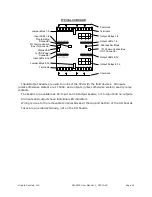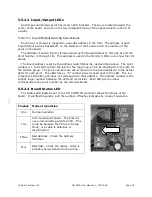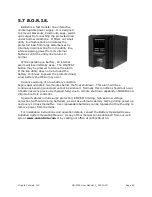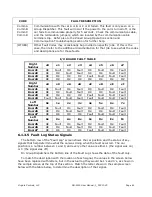
Virginia Controls, LLC
MH-3000 User Manual, 1_03C10-VC
Page 52
6.1.2
Show I/O Status
The "Show I/O Status" display allows the screen to display the status of the Inputs or
Outputs on one board. This display is useful for checking the integrity of the I/O boards and
the communications between the CPU board and the I/O boards. The display should agree
with the corresponding LEDs on the I/O boards.
The board number corresponds to the address set by the Address Switches on each I/O
board. The top left shows whether inputs or outputs are being monitored, and the bottom
left shows the board number being displayed.
INPUTS 0011 0010
Board2 0100 0110
The right side shows the status of the inputs or outputs. The status will be a "1" if the
signal is on, or a "0" if the signal is off. The order of the bits corresponds to the order of the
LEDs on the I/O board, that is, the top left bit corresponds to Point 1, top right is point 8,
bottom left is point 9 and bottom right is point 16. In the example above, the Inputs on
Board # 2 are being monitored, and points 3,4,7 (top line) and points 10,14,15 (bottom
line) are all on.
If an I/O Fault is showing on the Status Screen, and the data on the Show I/O Screen
matches the I/O boards, then the checksum in the communication is incorrect. This will
cause the CPU to ignore the data, and not pass it to the main program. To determine which
board is causing the communication failure, refer to the section on troubleshooting
suggestions for I/O board faults.
6.1.2.1
Moving Around in I/O Status Screen
Press Nxt or Prv to scroll through the I/O.
Press Aux to toggle between Inputs and Outputs.
Press Esc to return to the Run Mode menu screens.
The keys 0 - 9 ,
.
and Ent are not used in this mode.
6.1.3
Show Fault Log
The “Show Fault Log” screen allows the controller fault log to be viewed. This log shows
the fault number, the time stamp of the fault, the fault code, and critical data when the fault
occurred, including the floor position of the car and the status of certain key signals.
As shown in the description of the faults below, some of the faults logged are not faults,
but events that are useful to know in the maintenance and operation of the elevator.
The controller stores the last 63 faults in battery backed RAM memory.
When a new fault occurs, all the existing faults are moved down to the next fault
location, and fault 63 is erased. The most recent fault is stored in fault location 00, and the
order of the faults in the fault log is the order in which the faults were logged, with the most
recent faults at the top of the fault log table.






























